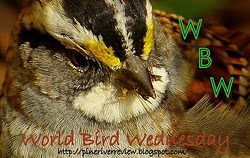Having migrated from New Guinea and Indonesia, between August and October, the Channel-Billed Cuckoo
Scythrops novaehollandiae, makes itself evident by a loud, raucous, and to me, a somewhat eerie
scream-like call. Often heard at night also.
Birds in Backyards informs that this is the largest
parasitic cuckoo in the world; you can listen to an MP3 on their link.
It was just this alert, that had me out the back door with my camera recently to try and get a photo for World Bird Wednesday. The cuckoo was way high in this huge angophora, showing its lovely peeling bark at this time of year; looking glorious and revealing all the rustic tones in the process.
There was an ever increasing mob of
Noisy Miners Manorina melanocephala, causing chaos and wanting the cuckoo 'out' of there.
Photo of Noisy Miners taken in differing location.
From a distance I could only try and see if I'd be lucky enough to capture the cuckoo seemingly hidden in part, by the network of branches and foliage. I'm sure he was watching me, and being determined not to budge and make it a better shoot. As I'd look up into that tree to sus out which crop of foliage he was inside of first, aiming the camera and then trying to relocate to
kind of where I felt he was, wasn't so easy.
In the end it was just do it, and hope for the best.
Now if I could just pull away that foliage hanging in front of your face.....
Ah! That's better but not quite there; your tail .....
This one was in my archive folders, a channel-billed cuckoo in the very same tree.
Birds in Backyards informs also that, "this cuckoo lays its eggs in the nests of the Australian Magpie, the Pied Currawong, and members of the Crow family".
for


















































